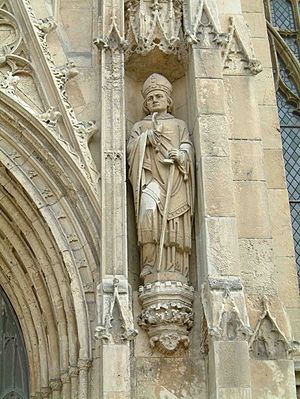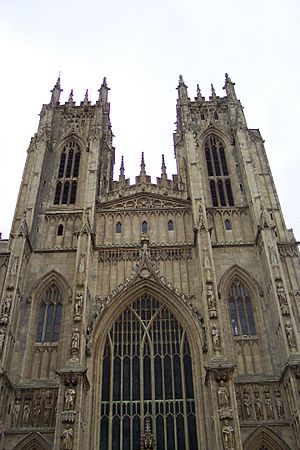John of Beverley facts for kids
Quick facts for kids John of Beverley |
|
|---|---|
| Bishop of York | |
 |
|
| Diocese | York |
| In Office | 705 – 718 |
| Predecessor | Bosa of York |
| Successor | Wilfrid II |
| Other posts | Bishop Emeritus of York (718–721) |
| Orders | |
| Consecration | 25 Aug 687 by Theodore of Tarsus |
| Personal details | |
| Born | date unknown Harpham, England |
| Died | 7 May 721 Beverley, England |
| Buried | Beverley Minster |
| Previous post | Bishop of Hexham (687–705) |
| Sainthood | |
| Feast day | 7 May |
| Venerated in | |
| Canonized | 1037 by Pope Benedict IX |
| Shrines | Beverley Minster |
John of Beverley was an important English bishop. He lived a long time ago, in the kingdom of Northumbria. He served as the bishop of Hexham and then the bishop of York. Being the Bishop of York was a very important religious job.
John also helped start the town of Beverley. He built the first building there, which was a monastery. People believed John could perform miracles during his life and even after he died. The Catholic Church made him a saint in 1037. Since this was before a big split in the church in 1054, he is also seen as a saint by the Eastern Orthodox Church.
Contents
John's Early Life and Education
John was born in a place called Harpham, in Yorkshire. His parents were from a noble family. Some stories say he studied in Canterbury under a teacher named Adrian. Other stories mention Oxford, but these might not be true.
We know for sure that John was part of the Whitby community. This was a religious group led by St Hilda. His friend, a famous historian named Bede, wrote about this. John became known as a great preacher. He was very smart and good at explaining the Bible.
Becoming a Bishop
In 687, John became the bishop of Hexham. He was made a bishop by Theodore of Tarsus, who was the Archbishop of Canterbury. Later, in 705, John was promoted. He became the bishop of York. This was a very important role.
As bishop, John worked hard. He visited many places and helped poor people. He also took care of students and taught them himself. He even ordained Bede, his friend, as a deacon and then as a priest. Around 717, John decided to retire. He moved to a monastery he had built in Beverley. He passed away there on May 7, 721.
Why John Became a Saint
John was made a saint in 1037. His special day, or feast day, is celebrated every year on May 7. Another celebration for him is on October 25. Many people believed John performed healing miracles. He had many students who looked up to him.
His popularity helped the town of Beverley grow and become rich in the Middle Ages. People admired his knowledge and his good character. Around 1066, a writer named Folcard wrote a book about John's life. Another book about his miracles was written later by William Ketel. This book first mentioned that King Æthelstan visited Beverley.
John's Banner and Shrine
John's banner was first mentioned in 1138. A leader named Thurstan used it in a battle called the Battle of the Standard. By 1266, people in Yorkshire believed that if Beverley sent one man with John's banner, it was enough for the royal army.
In 1292, a new shrine was ordered for John. A contract shows it was to be made of silver and gold. It would be 5 feet long and 1 foot wide. It was designed to be beautiful, with figures and decorations.
King Edward I greatly admired John. He helped make John's worship more popular. In 1295, Edward set up a special church service in Beverley Minster to honor the saint. In 1301, he gave money to help build the shrine.
On October 25, 1307, John's bones, or relics, were moved to this new tomb. Edward I visited Beverley Minster several times. He took John's banner with him when he went to fight in Scotland. Other kings like Edward II, Edward III, and Henry IV also used the banner in their wars.
Later History of John's Tomb
During the Middle Ages, John's name was also part of a story. It was about a hermit who did bad things but still received God's kindness. This story was printed in a Dutch book around 1512.
Henry V believed John helped him win the Battle of Agincourt. This battle happened on the same day John's relics were moved. Henry made John one of the special protectors of the royal family. He ordered that John's feast day be celebrated across England. Henry and his queen visited Beverley in 1420 to honor the saint.

In 1541, King Henry VIII ordered John's shrine to be destroyed. This was part of a big change in England called the English Reformation. The contents of the shrine disappeared.
In 1664, workers found a hidden space under the floor of the minster's main area. It was made of stone, about 15 feet long and 2 feet wide at one end. Inside, they found ashes, beads, and metal pins. There was also a lead casing with an inscription. It said that the church burned in 1188. It also said that in 1197, John's relics were found and put back in that spot.
In 1738, when a new floor was put in, the same relics were found again. They were placed back in the same spot, under an arched brick vault. A marble slab now covers this spot.
The inscription on the tomb today says: HERE LIES
THE BODY OF SAINT JOHN OF BEVERLEY
FOUNDER OF THIS CHURCH
BISHOP OF HEXHAM AD 687–705
BISHOP OF YORK A.D. 705–718
HE WAS BORN AT HARPHAM
AND DIED AT BEVERLEY
AD 721
Modern Celebrations
Today, John's feast day is still celebrated in Beverley. On the Thursday closest to May 7, the church choir and others from Beverley Minster go to the church in Harpham. They walk to a well that is decorated with flowers. After singing and praying, they return to the church for a special evening service.
On the Sunday closest to May 7, town officials march in a procession. They enter the minster through the main door. During the service, children from Harpham bring primroses. These flowers are gathered from the woods nearby. The flowers are placed around John's tomb.
Two other famous people, Julian of Norwich and John Fisher, were also devoted to John of Beverley.
John's Writings
John Bale, a historian, said that John of Beverley wrote several books. None of these books exist today. They included:
- Pro Luca exponendo (a book explaining the Gospel of Luke)
- Homiliae in Evangelia (sermons on the Gospels)
- Epistolae ad'Herebaldum, Audenam, et Bertinum (letters to Herebald, Audena, and Bertin)
- Epistolae ad Hyldant abbatissam (letters to Abbess Hilda)

